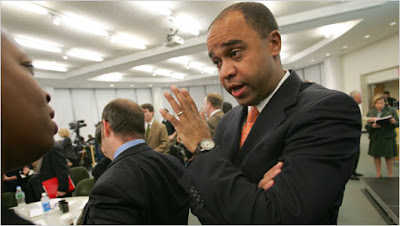According to this article in the Washington Post, the White House is hosting a day long conference today about the future of American urban policy. Heads of relevant departments and agencies will attend, and the President is expected to give remarks as well.
In February, President Obama created the Office of Urban Affairs (OUA), and selected Adolfo Carrión Jr. (bio) to direct it. According to this article, the Director intends to “bring agencies together to change urban growth patterns and foster opportunity, reduce sprawl, and jump-start the economy.”
 Adolfo Carrión Jr. – photo from Ezra Klein
Adolfo Carrión Jr. – photo from Ezra KleinThe executive order that established the OUA states that the Office will “take a coordinated and comprehensive approach to developing and implementing an effective strategy concerning urban America”
The event today will serve as a semi-official start to the OUA, and will be the basis for a several-month long tour of urban America. Officials will visit cities across the nation in an effort to better understand the needs of our metropolitan areas.
OUA’s mission does not come without some opposition. Some worry that reexamining our current public policy creates a dangerous precedent of federal meddling in local affairs. Director Carrión seems to think just the opposite will occur. From yesterday’s Washington Post:
“For too long government has operated from the top down,” said Carrión. “We’ve always heard why does the national government send down these unfunded mandates, under funded mandates, mandates that are not necessarily universally applicable. The bottom-up approach speaks to the need for this to be flexible.”
Although no official site yet exists for the OUA, the articles, executive order, and this page on the White House website seems to indicate that the office wants to work with local municipalities to help provide the support they need to carry out what works best for them. In general, it appears that the President’s agenda will focus on bolstering the strength of cities as economic, social and cultural incubators, while also working to promote sensible growth and regional efficiency.


